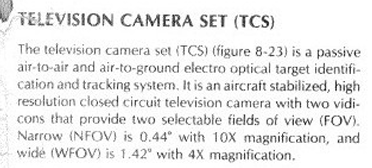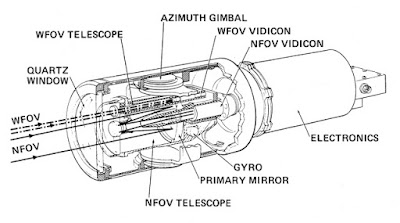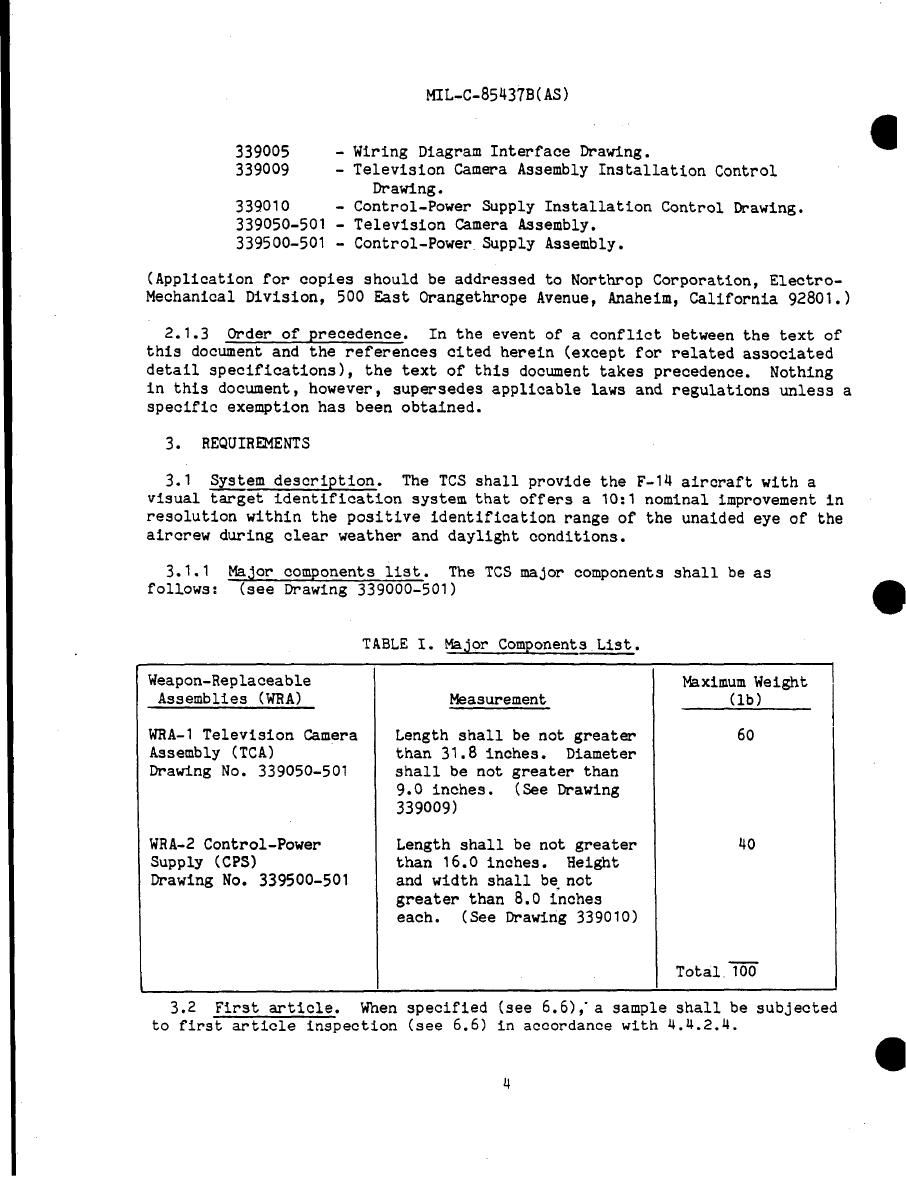Isn’t it A model?
The one carrying the missiles? No. This was taken from an F-14D expo showing off the AMRAAM and other future capabilities. The little fin slots the F-14A’s have aren’t present here. And even if they were, earlier F-14Ds and some D(R)s kept the slots.
Does LAU-138 had some loadout limitation on station 1B/8B?
I see some discussion that explain LAU-138s on station 1B and 8B couldn’t access the coolant bottle which would make it useless when trying to carry an sidewinders. It still works if you need additional CMs and doesn’t need missiles.
The context, if other people want to chime in:
Spoiler

Sure
Now regardless of how your [electro]optical system works internally, what you are ultimately doing is taking a 1.5 deg arc slice of the world and projecting it on a display
Magnification is also alternatively defined as the ratio between the size of the image and the size of the object
So if the FoV of both systems is stated to be ~1.5 deg, it means an object that takes up an arc of 1.5 deg at distance d, will take up the whole screen on both systems
And if the screens are roughly the same size and the viewer-screen distance is roughly the same, how can there be any difference in magnification?
Unless my assumption is incorrect, and when documents state an “FoV of 1.5 deg” it doesn’t mean that the whole screen is displaying a 1.5 deg arc slice of the world …
The only way I can explain why ~1.5 deg FoV would be 4x in F-14 and 16x in a Harrier is if the display size / head-display distance is (assumed to be) four times as much in the Harrier as it’s in the F-14 …
Or perhaps they factored in the limitations of the Vidicon and CRT display (and the image quality loss in the whole system) as well, and the “10X” figure is a performance figure rather than actual magnification.
I.e. With this system you can identify stuff at 10x the distance that you can with naked eye.
Which would explain why going from 1.42 WFoV to 0.44 NFoV takes you from “4X magnification” to “10X Magnification” instead of: 1.42 / 0.44 * 4 = 12.91
I believe it just uses the same definition as with cameras, that being the magnification it lists is the magnification at the sensor.
But I think you’re right. The TCS is underperforming actually because of this. FoV based zoom is much more accurate modelling of these ‘digital’ sights (one that put the image on a display), as indeed the apparent magnification only is a function of the viewing distance and size of this display.
Apparently irl you could ID fighter sized targets at 10 miles with the TCS. With a 0.44° FoV the target of say 15m length at 10 miles (~123m diameter coverage at 10 miles) occupies a bit more than 12% of the screen, with enough resolution this seems plausible. With the current in-game 10x magnification (resulting in a 7.37° FoV) this is pretty much impossible (target of 15m in a 2km radius is <1%).
The magnification they give is more important if Gaijin ever gets to modelling sensor resultion/size. Because I think it does affect the image quality. And of course magnifcation for ground vehicles (older ones at least) stay relevant, because the sensor would be your eye (so magnifcation based modelling is more accurate there).
Sticking to the magnification = magnification at the sensor definition. This 2.5x zoom difference (instead of 3.23x difference) is because the TCS uses a completely different lens and detector for the NFOV and WFOV, so they aren’t related to eachother like this.
Spoiler

“The F-22 does what suits the wording, the Eurofighter doesn’t.”
didnt you say there’s no definition for supercruise?
I think “magnification at the sensor” is irrelevant here as obviously the optical system is designed such that the size of the image (of the 1.5 deg arc) matches the size of the sensor …
AFAIK the 1.42 WFoV uses a 5/8" Vidicon and the 0.44 NFoV uses a larger 1" Vidicon (For improved image quality in NFoV). So the ratio of “magnification at the sensor” will be:
(1 / 0.44) / ((5/8) / 1.42) = 5.16
So it’s even higher than the 3.23 ratio of magnifications of the whole system (“At the display”), rather than being closer to the 2.5 ratio (10X/4X) stated in the manual.
Plus, stating the magnification at the sensor" seems irrelevant as it pretty much indicates nothing …
Hence why TGP documentations specify FoVs rather than magnification, as the latter would depend on what display you hook it up to and what distance you sit from it …
Magnification at the sensor matters for image quality. By magnifying the image (for the sensor), you can get away with a less detector element dense array (the limiting factor for such detectors, especially older), as you’re spacing apart the details over a larger area.
But apart from that, yes it indeed bears no information for the magnification of the image from the pilot’s pov. So I think this can be bug reported, to use the FoV values. The magnification values are probably only listed to specify the lenses used or to gauge image quality.
I don’t think this makes any sense. I believe what you’re doing here is essentially comparing the 1" with another 1" detector where you only consider 5/8th of its size, all assuming same focal length. If focal length is the same, to fill the 5/8th detector, the FoV would not be 1.42° anymore. In any case, detector size has no impact on magnification, only FoV and focal length. And since the TCS uses most likely two distinct lenses for WFOV and NFOV, thus different focal length, the 2.5 ratio between magnification at the sensor is achievable.
Honestly I don’t even know if I am making sense rn, it’s a bit late again for me. But if you want to bug report for the TCS, I think these are the only relevant images:
Spoiler
You can also find these in a DCS forum post somwhere, there are some more pages (9 more), but they’re not as relevant I think. AFAIK the rest of the document isn’t available online unless you buy it.


We should have the numbers somewhere
https://mil-spec.tpub.com/MIL-C/MIL-C-85437B/MIL-C-85437B00001.htm
“That offers a 10:1 Nominal improvement in resolution”
“NFOV = 7.7 Mrad | WFOV = 24.7”
“525 Scan lines per frame, Unity (1:1) camera scan aspect Ratio”
While I do think the “4x-10x” figure is a performance figure (I.e. the ratio of the distance that objects can be identified through the system vs naked eye), specifying such a figure as “magnification at the sensor” which I literally have not seen specified for any TGP, seems very odd …
Because that alone tells you virtually nothing about “image quality” as what matters more would be aperture size etc …
I.e. what matters the most is the amount of light you are letting in
You can then take that light and focus it on a small low pitch sensor or a large high pitch sensor of the same resolution and get the same image …
I think the second part is correct
I think it’s a performance figure … I.e. if you can identify an object at 1nm with naked eye you can identify the same object at 10nm through the system …
Nice, I missed that part
So my assumption was correct:
https://community.gaijin.net/issues/p/warthunder/i/c0HtEJPi8n3l
I did not use the FoV of Maverick as a basis to calculate the zoom or FoV of the TCS
The IRMV was just an example to show that “Magnification” can vary for the same FoV and is not a good metric for adjustment.
But not only I provided a direct source for the FoV (which is what the game uses) of TCS, but also the source explicitly states that the “10X” figure (That other sources specify for “Magnification”) is not the actual magnification but rather the amount of improvement in identification range over the naked eye.
Sensor size is completely irrelevant here, as FoV is what matters
0.44 FoV means the MFD is showing a 0.44 deg arc slice of the world. And that’s how the game models TGPs; And that’s how all TGPs provide their specifications …
If the exact magnification is known, the magnification will take precedence, using FoV is a temporary solution.
And I explained why the “exact magnification” is not known
10X is not magnification
It’s “Improvement in identification range over naked eye”
B- This is further confirmed by the first source, stating that the “10:1” ratio (or “10X magnification” as specified in other sources) is actually the “Improvement in identification range over unaided eye”; So the “4X-10X magnification” figure is not the actual magnification but rather a performance figure of identification range improvement over the naked eye.
Thus the actual magnification of the system should be adjusted based on the provided FOV values.
Plus this is not an optical tank sight with gunners head against the eyepiece
This is a display hooked to a camera
“10X” figure even if it was magnification, would mean the angular size of the target on the MFD as seen by the pilot with his head in the assumed distance would be 10 times the angular size of the target as seen by naked eye.
Which is also not the case now …
There’s really no particular reason to look at it. The TISEO system, which is almost identical to the TCS, is also known to have a magnification of 4-10x.
The TISEO was an electronic telescope mounted in the left wing of the F-4E. It had 4-power and 10-power magnifications.
“10X” means the angular size of the object as seen by the pilot through the MFD would be 10 times the angular size of the object as seen by his naked eyes.
Again, this is not an optical tank sight with gunner’s head against the eyepiece … This is a camera projected on an MFD.
That’s why TGP documents only give you FoV values and that’s why they should all be adjusted using FoV only (Unlike tank sights)
Does this look like “10X magnification” to you?
Regarding: https://community.gaijin.net/issues/p/warthunder/i/c0HtEJPi8n3l
Im 99% sure gaijins gonna make the F-14D a premium at this point









